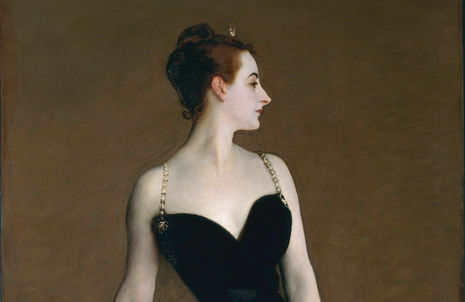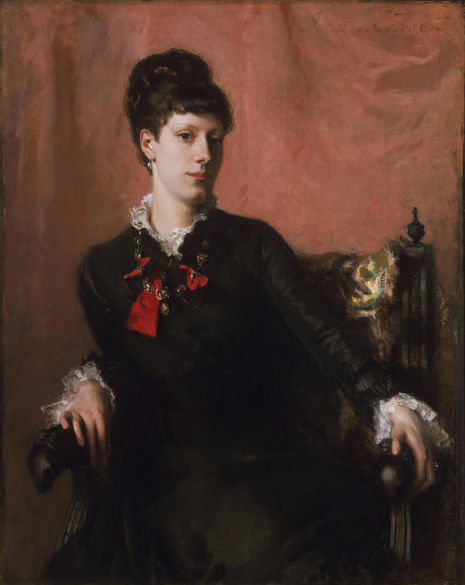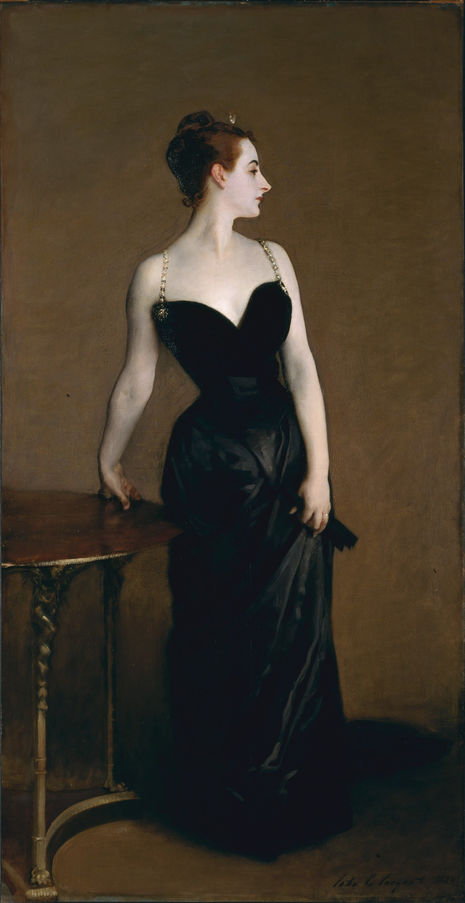The legacy of a Parisian Scandal: John Singer Sargent’s ‘Portrait of Madame X’
John Singer Sargent’s ‘Portrait of Madame X’ scandalised the Paris Salon upon its debut in 1884. Caterina Bragoli unmasks the eponymous subject of the painting and considers what the portrait’s reception has meant for artist, sitter, and artistic posterity.

Virginie Amélie Avegno Gautreau’s side profile, immortalised in paint by John Singer Sargent, remains one of elusive contrast. Teetering between the veiled and unveiled, Sargent presents one half of Gautreau’s face in a porcelain so bright, it draws attention to every contour and feature; he shrouds the other half, invisible to the eye, in a demure, almost pallid umber. Both delicate and mystifying, Gautreau’s “unpaintable beauty” appears to a modern audience as slightly forbidding and austere at most, yet in the eyes of French high society in 1884, its effect was so scandalous that it tarnished Sargent’s career, forcing him to flee France. In fact, Sargent’s labelling of Gautreau’s beauty as “unpaintable” was a haunting anticipation of the belief of man: that her beauty shouldn’t have been enshrined in paint.
“It’s both assertive and impenetrable: the undaunted depiction of her body as the focal point of the piece was extraordinarily avant-garde”
Gautreau, popularised under the name Amélie, became an infamous figure in Parisian high society, after marrying a wealthy French banker. However, it was not her husband that afforded this expatriate such status: she was regarded as a professional beauty, having previously garnered artistic interest from accomplished painters such as Edward Simmons.
Sargent stumbled across Gautreau in the 1880s, after his debut at the Salon in 1877 with a portrait of his longtime friend Frances Sherborne Ridley Watts; this portrait was totally different to his famed later piece, with Watts’ modestly high-collared dress and seated, unassuming pose contrasting the intrepid exhibition of Gautreau’s skin. Immediately captivated by Gautreau’s unparalleled and striking features, Sargent noted in a letter: “I have a great desire to paint her portrait and have reason to think she would allow it and is waiting for someone to propose this homage to her beauty.”

Sargent’s innocent desire to eternise Gautreau soon morphed into a scandal among the frequenters of the Salon. He did indeed pay homage, but not just to her striking face. Rather, Sargent cast the spotlight on Gautreau’s body, by insisting that she pose with her body facing him and her face turned away. By extending her right hand to rest on a side table, Sargent elongated her body, thus drawing attention to her neck and arms. It’s both assertive and impenetrable: the undaunted depiction of her body as the focal point of the piece was extraordinarily avant-garde, leading Salon audiences to be bewildered and outraged by this subversive depiction of a woman. Yet, the beguiling concealment of the majority of her face equally leads audiences to wonder just who this bold Madame X is.
“The distressed audience couldn’t seem to comprehend a woman’s body being used as a paradigm of her personal sexuality”
Hanging in the Metropolitan Museum of Art’s American wing, the portrait’s imposing two-metre tall gold frame draws the eyes of onlookers towards the bodily elegance of Gautreau. However, our modern reception masks its original transgressive nature: Sargent initially depicted Gautreau in a tightly silhouetted black gown, with chained straps doing very little to conceal her pearlescent shoulders and décolletage. In fact, originally, Sargent chose to drape one strap down Gautreau’s arm; this inadvertently caused further outrage. To spectators past, it was a brazen attempt to barely veil Gautreau’s body, suggesting that if one strap can breezily slip, so can the rest.
Much like the reception of Manet’s ‘Olympia’ twenty years prior, the distressed audience couldn’t seem to comprehend a woman’s body being used as a paradigm of her personal sexuality, rather than being contained and stowed away in favour of propriety. Even Gautreau – a woman fiercely aware of her beauty, and inclined to weaponize it for advancement by becoming the archetypal ‘Parisienne’ – felt that it was best to anonymise her painted figure: thus Madame X was born.

The name ‘Madame X’ was formulated as a disguise, a way of avoiding public scandal and representing the female body without consequence (this of course failed, and Gautreau’s mother requested the painting be removed from the Salon). What Sargent and Gautreau didn’t know was that their anonymising safety net would inaugurate a cultural movement. By emphasising the incognito with a single letter, the ‘X’ encompassed all women and their ownership over their bodies.
Despite having to leave France due to the humiliation that ensued, Sargent’s foray into the world of riotous female dressing paved the way for later artists. Gautreau – perhaps somewhat galvanised by the scandal retrospectively – sat for another portrait by Gustave Courtois, this time in a white gown, but the historic symbolism of white and purity should not lead our interpretation astray. Again, Courtois features a falling strap, and the alabaster organza and lace seem to entwine with Gautreau’s skin, so much so that they essentially flow into one. It proffers the illusion of a heightened sexuality and ownership over her body, clothing and its reception; there is no incognito here.
Whilst Sargent’s fantasy of being an artist for the Parisian elite was shattered, his scandalous portrait of Madame Gautreau permanently altered the discourse surrounding female promiscuity and its place in the milieu of high-society France. It inspired novels such as I Am Madame X by Gioia Diliberto and contemporary fashion pieces by designers like Luis Estévez. Our progressive, modern reception of art must always pay homage to this reticent portrait and its subject, laden with misdemeanour.
 News / Cambridge academics stand out in King’s 2026 Honours List2 January 2026
News / Cambridge academics stand out in King’s 2026 Honours List2 January 2026 Interviews / You don’t need to peak at Cambridge, says Robin Harding31 December 2025
Interviews / You don’t need to peak at Cambridge, says Robin Harding31 December 2025 Comment / What happened to men at Cambridge?31 December 2025
Comment / What happened to men at Cambridge?31 December 2025 Features / “It’s a momentary expression of rage”: reforming democracy from Cambridge4 January 2026
Features / “It’s a momentary expression of rage”: reforming democracy from Cambridge4 January 2026 News / Varsity’s biggest stories of 202531 December 2025
News / Varsity’s biggest stories of 202531 December 2025










